Detailed Analysis of Corporations and Business Structures: Law Report
VerifiedAdded on 2020/10/23
|11
|3192
|142
Report
AI Summary
This report delves into the intricacies of corporations and business structures, offering a comprehensive analysis of various aspects relevant to forming and managing a business. It commences by outlining the benefits of incorporation, including asset protection and access to capital, while also comparing the risks associated with partnerships. The report then explains the process of incorporating a company under the regulation of the Australian Securities and Investment Commission (ASIC), detailing the roles of directors and shareholders. It further explores the general and statutory duties of directors, referencing case studies such as Eclairs Group Ltd vs JKX Oil & Gas Plc. Additionally, the report summarizes the legal requirements for making a large share offer to the public and the disclosure and reporting obligations for public companies. It concludes by examining the potential criminal liability of a director for insider trading, referencing supporting case law such as the Black Hills Case, and offers advice on shareholder resolutions and the impact of winding up on directors' roles and company assets.
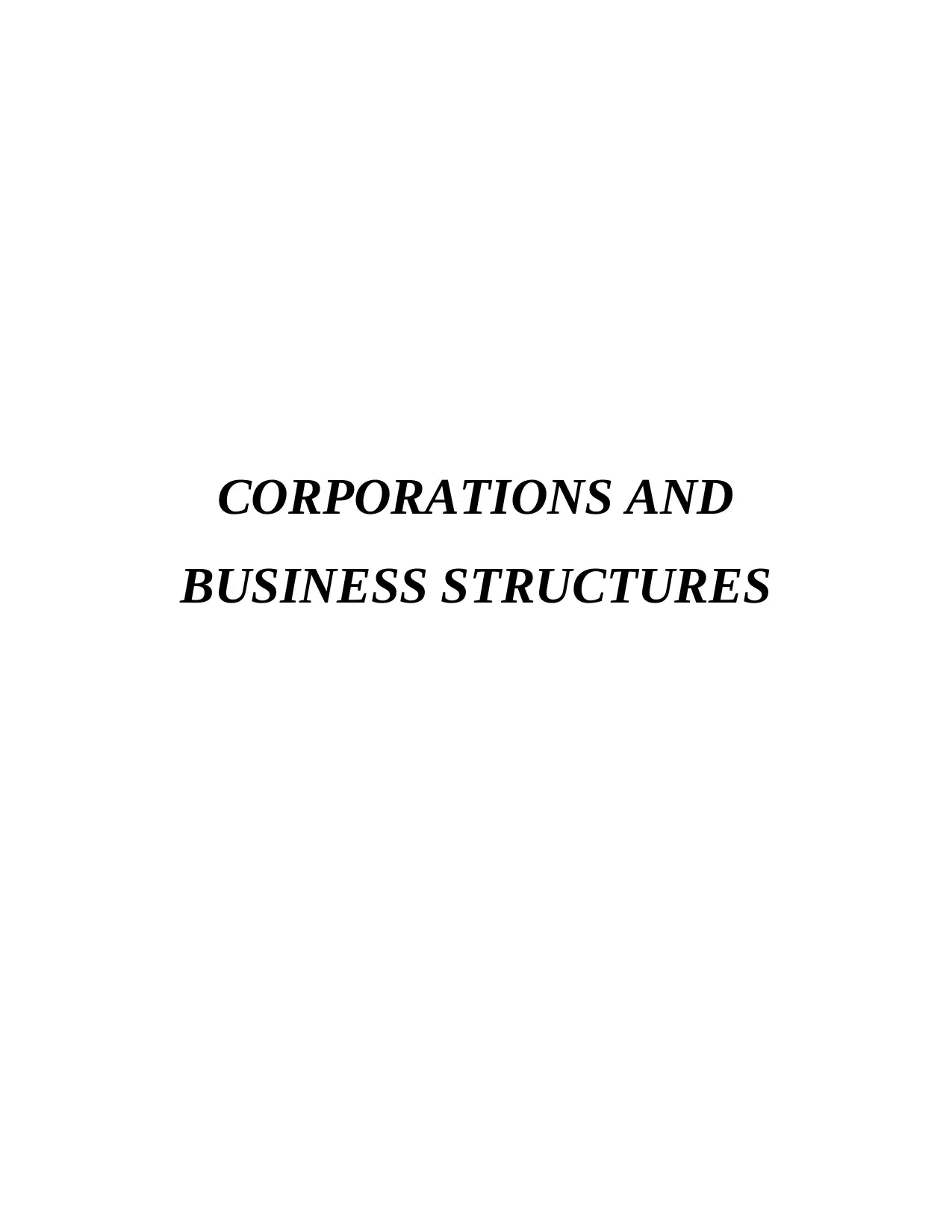
CORPORATIONS AND
BUSINESS STRUCTURES
BUSINESS STRUCTURES
Paraphrase This Document
Need a fresh take? Get an instant paraphrase of this document with our AI Paraphraser
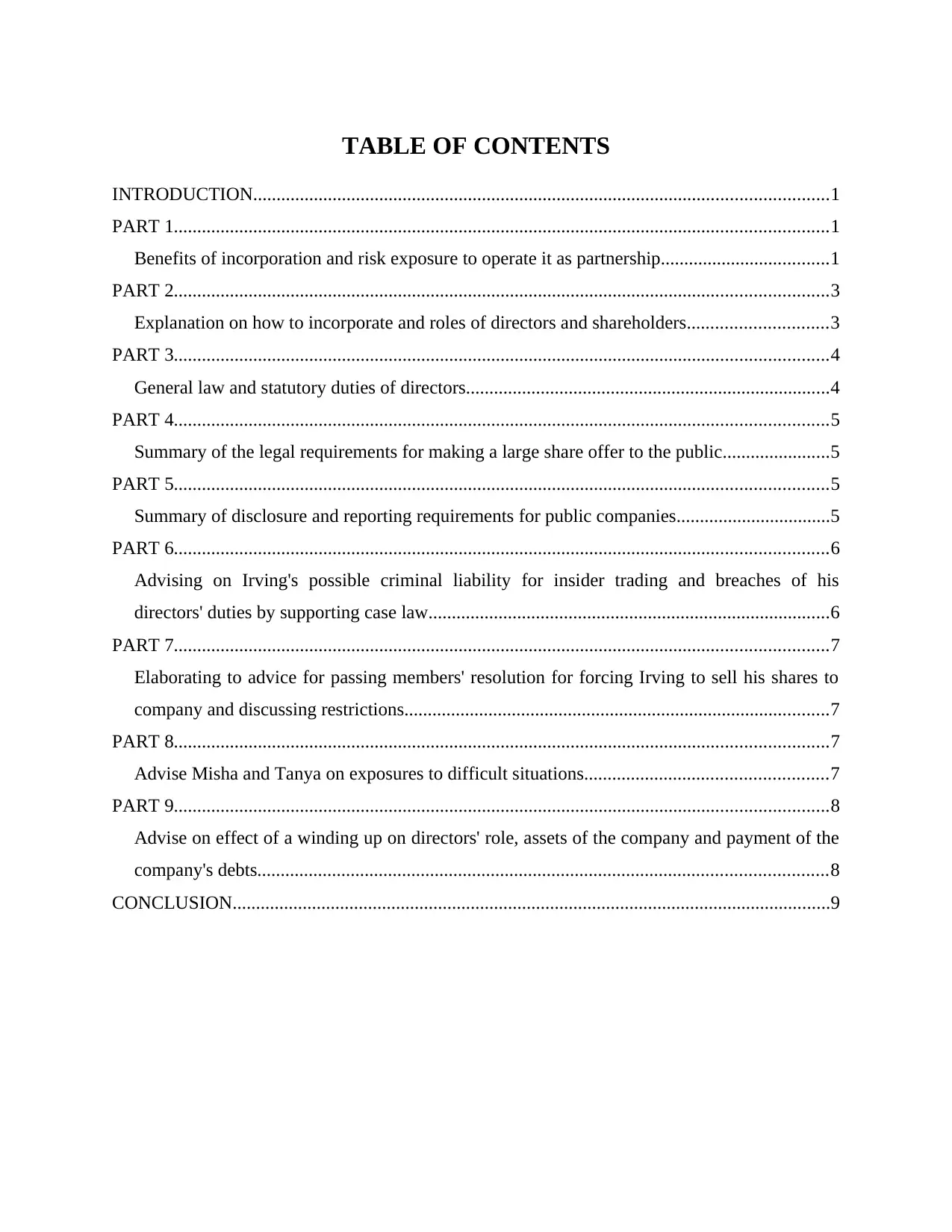
TABLE OF CONTENTS
INTRODUCTION...........................................................................................................................1
PART 1............................................................................................................................................1
Benefits of incorporation and risk exposure to operate it as partnership....................................1
PART 2............................................................................................................................................3
Explanation on how to incorporate and roles of directors and shareholders..............................3
PART 3............................................................................................................................................4
General law and statutory duties of directors..............................................................................4
PART 4............................................................................................................................................5
Summary of the legal requirements for making a large share offer to the public.......................5
PART 5............................................................................................................................................5
Summary of disclosure and reporting requirements for public companies.................................5
PART 6............................................................................................................................................6
Advising on Irving's possible criminal liability for insider trading and breaches of his
directors' duties by supporting case law......................................................................................6
PART 7............................................................................................................................................7
Elaborating to advice for passing members' resolution for forcing Irving to sell his shares to
company and discussing restrictions...........................................................................................7
PART 8............................................................................................................................................7
Advise Misha and Tanya on exposures to difficult situations....................................................7
PART 9............................................................................................................................................8
Advise on effect of a winding up on directors' role, assets of the company and payment of the
company's debts..........................................................................................................................8
CONCLUSION................................................................................................................................9
INTRODUCTION...........................................................................................................................1
PART 1............................................................................................................................................1
Benefits of incorporation and risk exposure to operate it as partnership....................................1
PART 2............................................................................................................................................3
Explanation on how to incorporate and roles of directors and shareholders..............................3
PART 3............................................................................................................................................4
General law and statutory duties of directors..............................................................................4
PART 4............................................................................................................................................5
Summary of the legal requirements for making a large share offer to the public.......................5
PART 5............................................................................................................................................5
Summary of disclosure and reporting requirements for public companies.................................5
PART 6............................................................................................................................................6
Advising on Irving's possible criminal liability for insider trading and breaches of his
directors' duties by supporting case law......................................................................................6
PART 7............................................................................................................................................7
Elaborating to advice for passing members' resolution for forcing Irving to sell his shares to
company and discussing restrictions...........................................................................................7
PART 8............................................................................................................................................7
Advise Misha and Tanya on exposures to difficult situations....................................................7
PART 9............................................................................................................................................8
Advise on effect of a winding up on directors' role, assets of the company and payment of the
company's debts..........................................................................................................................8
CONCLUSION................................................................................................................................9
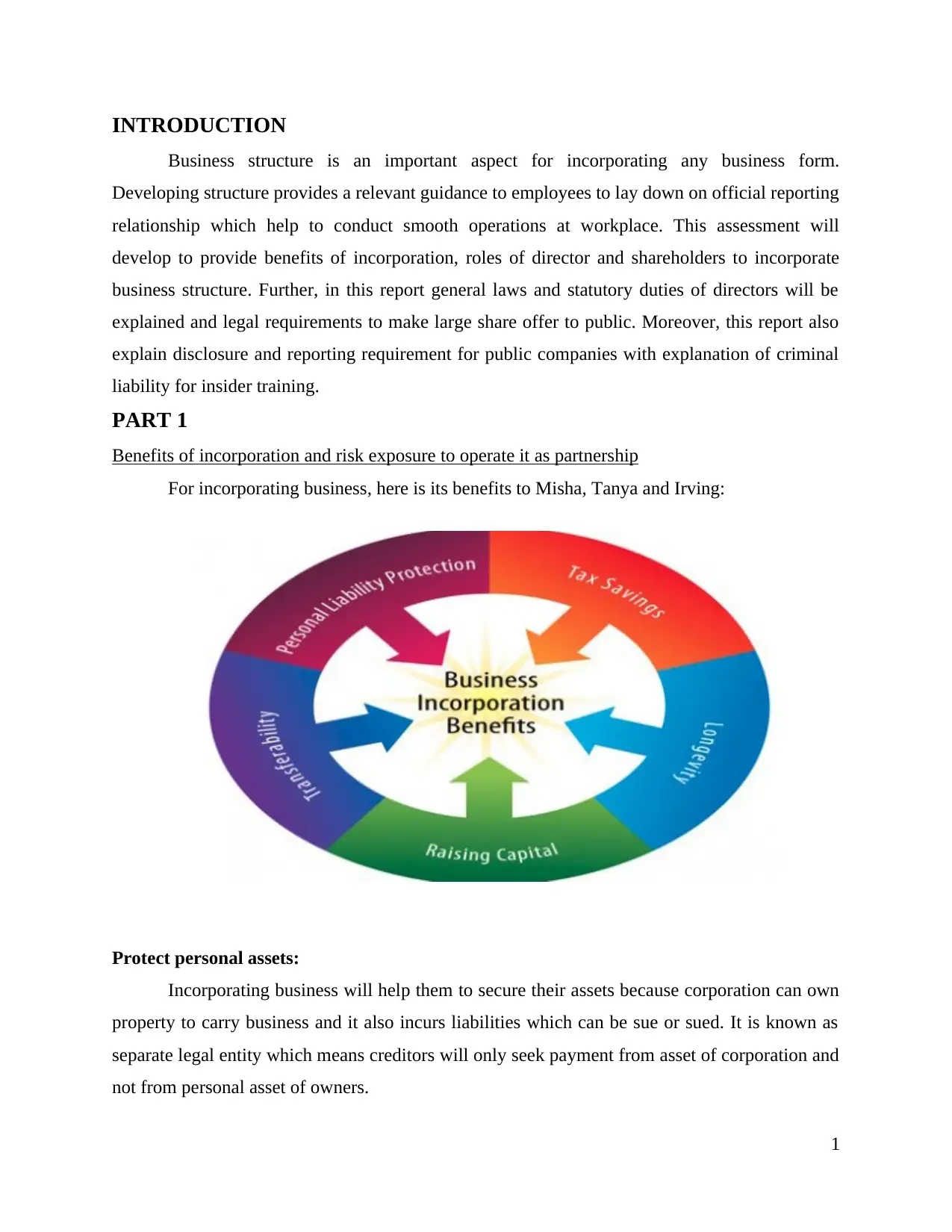
INTRODUCTION
Business structure is an important aspect for incorporating any business form.
Developing structure provides a relevant guidance to employees to lay down on official reporting
relationship which help to conduct smooth operations at workplace. This assessment will
develop to provide benefits of incorporation, roles of director and shareholders to incorporate
business structure. Further, in this report general laws and statutory duties of directors will be
explained and legal requirements to make large share offer to public. Moreover, this report also
explain disclosure and reporting requirement for public companies with explanation of criminal
liability for insider training.
PART 1
Benefits of incorporation and risk exposure to operate it as partnership
For incorporating business, here is its benefits to Misha, Tanya and Irving:
Protect personal assets:
Incorporating business will help them to secure their assets because corporation can own
property to carry business and it also incurs liabilities which can be sue or sued. It is known as
separate legal entity which means creditors will only seek payment from asset of corporation and
not from personal asset of owners.
1
Business structure is an important aspect for incorporating any business form.
Developing structure provides a relevant guidance to employees to lay down on official reporting
relationship which help to conduct smooth operations at workplace. This assessment will
develop to provide benefits of incorporation, roles of director and shareholders to incorporate
business structure. Further, in this report general laws and statutory duties of directors will be
explained and legal requirements to make large share offer to public. Moreover, this report also
explain disclosure and reporting requirement for public companies with explanation of criminal
liability for insider training.
PART 1
Benefits of incorporation and risk exposure to operate it as partnership
For incorporating business, here is its benefits to Misha, Tanya and Irving:
Protect personal assets:
Incorporating business will help them to secure their assets because corporation can own
property to carry business and it also incurs liabilities which can be sue or sued. It is known as
separate legal entity which means creditors will only seek payment from asset of corporation and
not from personal asset of owners.
1
⊘ This is a preview!⊘
Do you want full access?
Subscribe today to unlock all pages.

Trusted by 1+ million students worldwide
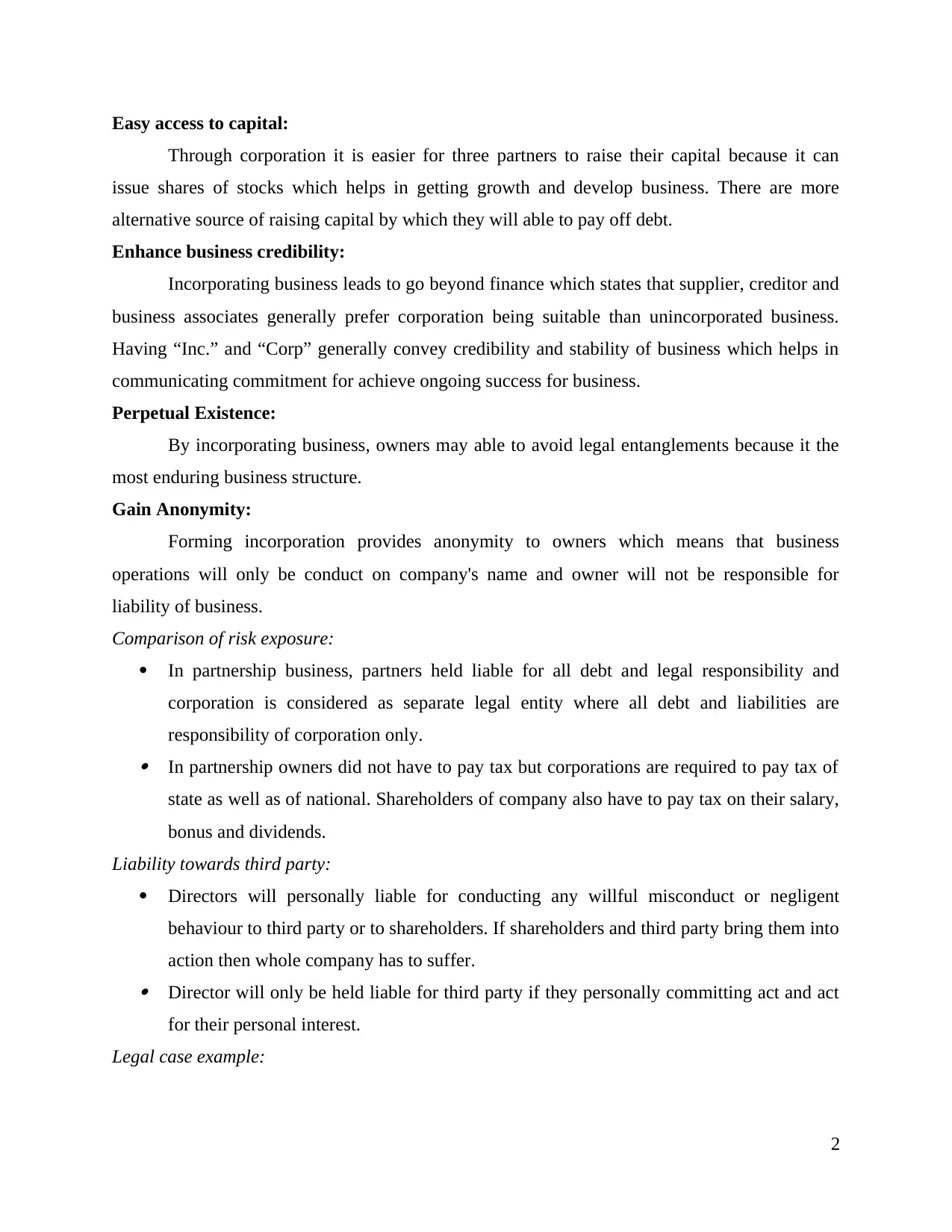
Easy access to capital:
Through corporation it is easier for three partners to raise their capital because it can
issue shares of stocks which helps in getting growth and develop business. There are more
alternative source of raising capital by which they will able to pay off debt.
Enhance business credibility:
Incorporating business leads to go beyond finance which states that supplier, creditor and
business associates generally prefer corporation being suitable than unincorporated business.
Having “Inc.” and “Corp” generally convey credibility and stability of business which helps in
communicating commitment for achieve ongoing success for business.
Perpetual Existence:
By incorporating business, owners may able to avoid legal entanglements because it the
most enduring business structure.
Gain Anonymity:
Forming incorporation provides anonymity to owners which means that business
operations will only be conduct on company's name and owner will not be responsible for
liability of business.
Comparison of risk exposure:
In partnership business, partners held liable for all debt and legal responsibility and
corporation is considered as separate legal entity where all debt and liabilities are
responsibility of corporation only. In partnership owners did not have to pay tax but corporations are required to pay tax of
state as well as of national. Shareholders of company also have to pay tax on their salary,
bonus and dividends.
Liability towards third party:
Directors will personally liable for conducting any willful misconduct or negligent
behaviour to third party or to shareholders. If shareholders and third party bring them into
action then whole company has to suffer. Director will only be held liable for third party if they personally committing act and act
for their personal interest.
Legal case example:
2
Through corporation it is easier for three partners to raise their capital because it can
issue shares of stocks which helps in getting growth and develop business. There are more
alternative source of raising capital by which they will able to pay off debt.
Enhance business credibility:
Incorporating business leads to go beyond finance which states that supplier, creditor and
business associates generally prefer corporation being suitable than unincorporated business.
Having “Inc.” and “Corp” generally convey credibility and stability of business which helps in
communicating commitment for achieve ongoing success for business.
Perpetual Existence:
By incorporating business, owners may able to avoid legal entanglements because it the
most enduring business structure.
Gain Anonymity:
Forming incorporation provides anonymity to owners which means that business
operations will only be conduct on company's name and owner will not be responsible for
liability of business.
Comparison of risk exposure:
In partnership business, partners held liable for all debt and legal responsibility and
corporation is considered as separate legal entity where all debt and liabilities are
responsibility of corporation only. In partnership owners did not have to pay tax but corporations are required to pay tax of
state as well as of national. Shareholders of company also have to pay tax on their salary,
bonus and dividends.
Liability towards third party:
Directors will personally liable for conducting any willful misconduct or negligent
behaviour to third party or to shareholders. If shareholders and third party bring them into
action then whole company has to suffer. Director will only be held liable for third party if they personally committing act and act
for their personal interest.
Legal case example:
2
Paraphrase This Document
Need a fresh take? Get an instant paraphrase of this document with our AI Paraphraser
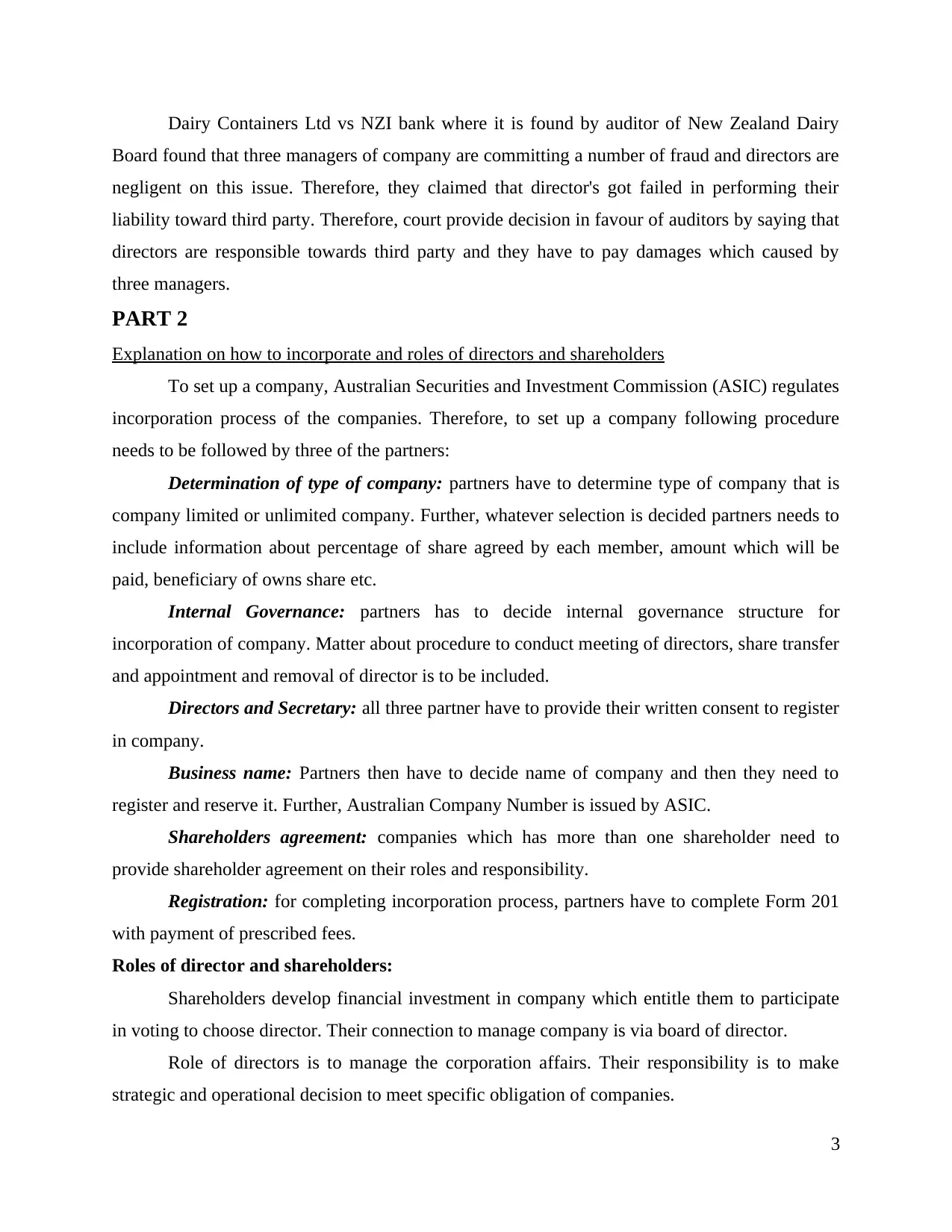
Dairy Containers Ltd vs NZI bank where it is found by auditor of New Zealand Dairy
Board found that three managers of company are committing a number of fraud and directors are
negligent on this issue. Therefore, they claimed that director's got failed in performing their
liability toward third party. Therefore, court provide decision in favour of auditors by saying that
directors are responsible towards third party and they have to pay damages which caused by
three managers.
PART 2
Explanation on how to incorporate and roles of directors and shareholders
To set up a company, Australian Securities and Investment Commission (ASIC) regulates
incorporation process of the companies. Therefore, to set up a company following procedure
needs to be followed by three of the partners:
Determination of type of company: partners have to determine type of company that is
company limited or unlimited company. Further, whatever selection is decided partners needs to
include information about percentage of share agreed by each member, amount which will be
paid, beneficiary of owns share etc.
Internal Governance: partners has to decide internal governance structure for
incorporation of company. Matter about procedure to conduct meeting of directors, share transfer
and appointment and removal of director is to be included.
Directors and Secretary: all three partner have to provide their written consent to register
in company.
Business name: Partners then have to decide name of company and then they need to
register and reserve it. Further, Australian Company Number is issued by ASIC.
Shareholders agreement: companies which has more than one shareholder need to
provide shareholder agreement on their roles and responsibility.
Registration: for completing incorporation process, partners have to complete Form 201
with payment of prescribed fees.
Roles of director and shareholders:
Shareholders develop financial investment in company which entitle them to participate
in voting to choose director. Their connection to manage company is via board of director.
Role of directors is to manage the corporation affairs. Their responsibility is to make
strategic and operational decision to meet specific obligation of companies.
3
Board found that three managers of company are committing a number of fraud and directors are
negligent on this issue. Therefore, they claimed that director's got failed in performing their
liability toward third party. Therefore, court provide decision in favour of auditors by saying that
directors are responsible towards third party and they have to pay damages which caused by
three managers.
PART 2
Explanation on how to incorporate and roles of directors and shareholders
To set up a company, Australian Securities and Investment Commission (ASIC) regulates
incorporation process of the companies. Therefore, to set up a company following procedure
needs to be followed by three of the partners:
Determination of type of company: partners have to determine type of company that is
company limited or unlimited company. Further, whatever selection is decided partners needs to
include information about percentage of share agreed by each member, amount which will be
paid, beneficiary of owns share etc.
Internal Governance: partners has to decide internal governance structure for
incorporation of company. Matter about procedure to conduct meeting of directors, share transfer
and appointment and removal of director is to be included.
Directors and Secretary: all three partner have to provide their written consent to register
in company.
Business name: Partners then have to decide name of company and then they need to
register and reserve it. Further, Australian Company Number is issued by ASIC.
Shareholders agreement: companies which has more than one shareholder need to
provide shareholder agreement on their roles and responsibility.
Registration: for completing incorporation process, partners have to complete Form 201
with payment of prescribed fees.
Roles of director and shareholders:
Shareholders develop financial investment in company which entitle them to participate
in voting to choose director. Their connection to manage company is via board of director.
Role of directors is to manage the corporation affairs. Their responsibility is to make
strategic and operational decision to meet specific obligation of companies.
3
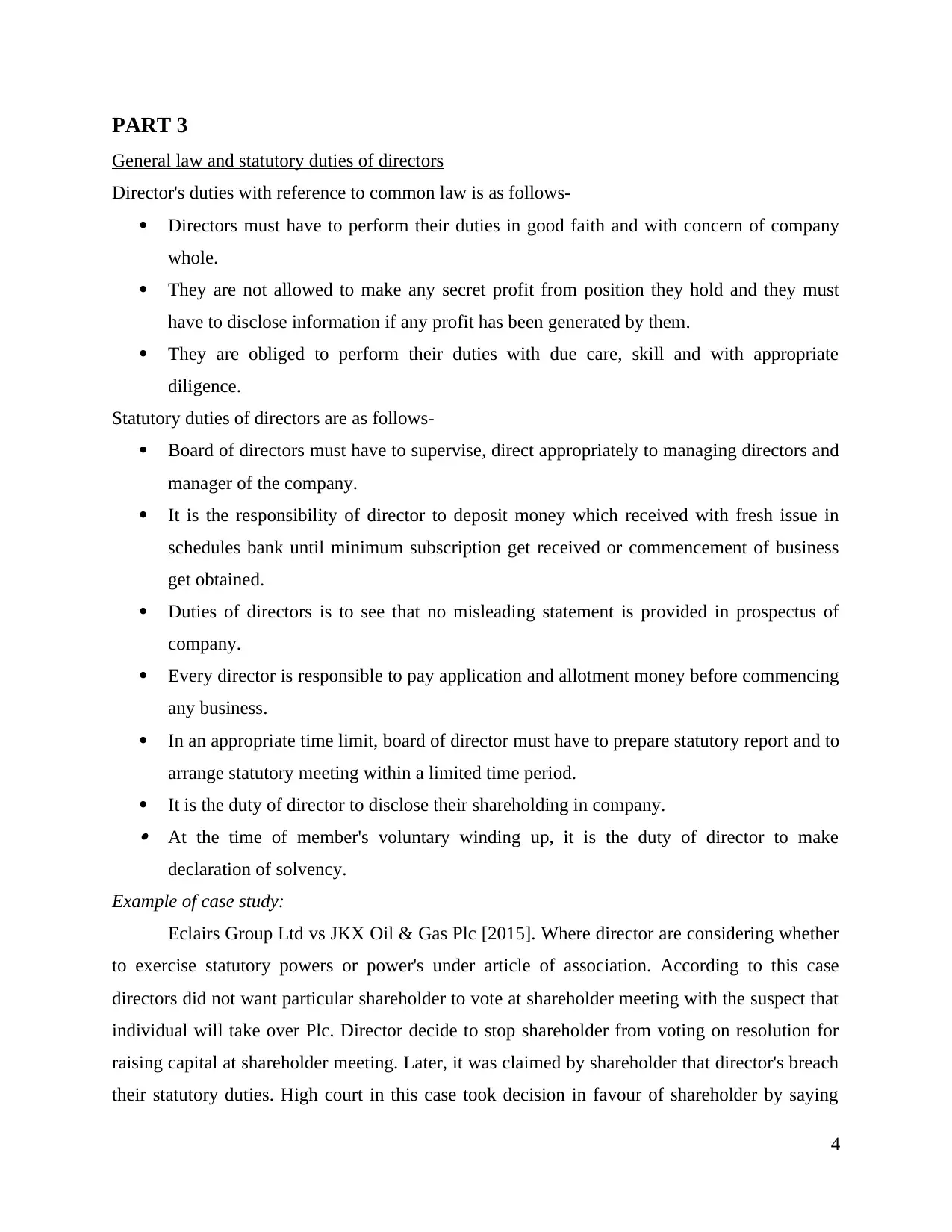
PART 3
General law and statutory duties of directors
Director's duties with reference to common law is as follows-
Directors must have to perform their duties in good faith and with concern of company
whole.
They are not allowed to make any secret profit from position they hold and they must
have to disclose information if any profit has been generated by them.
They are obliged to perform their duties with due care, skill and with appropriate
diligence.
Statutory duties of directors are as follows-
Board of directors must have to supervise, direct appropriately to managing directors and
manager of the company.
It is the responsibility of director to deposit money which received with fresh issue in
schedules bank until minimum subscription get received or commencement of business
get obtained.
Duties of directors is to see that no misleading statement is provided in prospectus of
company.
Every director is responsible to pay application and allotment money before commencing
any business.
In an appropriate time limit, board of director must have to prepare statutory report and to
arrange statutory meeting within a limited time period.
It is the duty of director to disclose their shareholding in company. At the time of member's voluntary winding up, it is the duty of director to make
declaration of solvency.
Example of case study:
Eclairs Group Ltd vs JKX Oil & Gas Plc [2015]. Where director are considering whether
to exercise statutory powers or power's under article of association. According to this case
directors did not want particular shareholder to vote at shareholder meeting with the suspect that
individual will take over Plc. Director decide to stop shareholder from voting on resolution for
raising capital at shareholder meeting. Later, it was claimed by shareholder that director's breach
their statutory duties. High court in this case took decision in favour of shareholder by saying
4
General law and statutory duties of directors
Director's duties with reference to common law is as follows-
Directors must have to perform their duties in good faith and with concern of company
whole.
They are not allowed to make any secret profit from position they hold and they must
have to disclose information if any profit has been generated by them.
They are obliged to perform their duties with due care, skill and with appropriate
diligence.
Statutory duties of directors are as follows-
Board of directors must have to supervise, direct appropriately to managing directors and
manager of the company.
It is the responsibility of director to deposit money which received with fresh issue in
schedules bank until minimum subscription get received or commencement of business
get obtained.
Duties of directors is to see that no misleading statement is provided in prospectus of
company.
Every director is responsible to pay application and allotment money before commencing
any business.
In an appropriate time limit, board of director must have to prepare statutory report and to
arrange statutory meeting within a limited time period.
It is the duty of director to disclose their shareholding in company. At the time of member's voluntary winding up, it is the duty of director to make
declaration of solvency.
Example of case study:
Eclairs Group Ltd vs JKX Oil & Gas Plc [2015]. Where director are considering whether
to exercise statutory powers or power's under article of association. According to this case
directors did not want particular shareholder to vote at shareholder meeting with the suspect that
individual will take over Plc. Director decide to stop shareholder from voting on resolution for
raising capital at shareholder meeting. Later, it was claimed by shareholder that director's breach
their statutory duties. High court in this case took decision in favour of shareholder by saying
4
⊘ This is a preview!⊘
Do you want full access?
Subscribe today to unlock all pages.

Trusted by 1+ million students worldwide
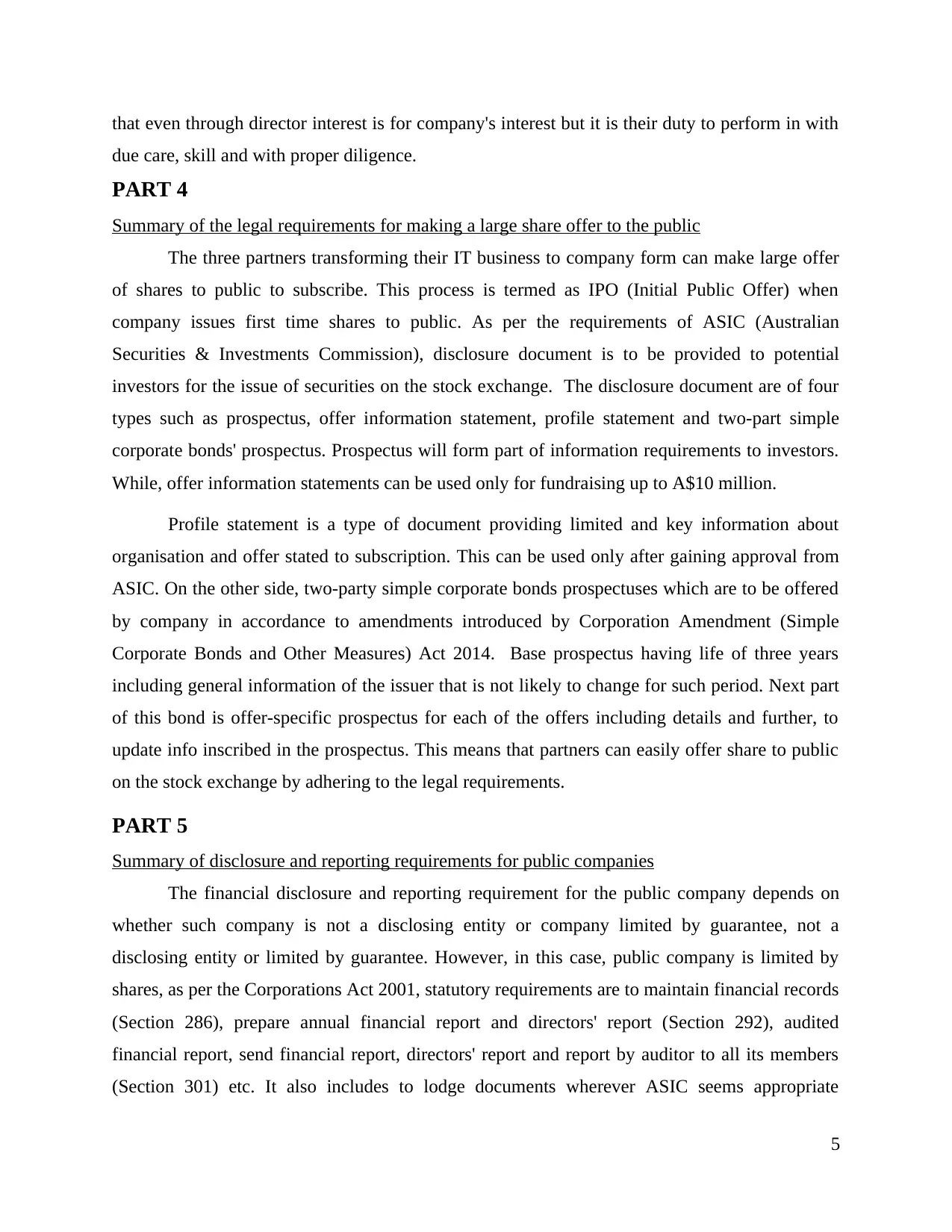
that even through director interest is for company's interest but it is their duty to perform in with
due care, skill and with proper diligence.
PART 4
Summary of the legal requirements for making a large share offer to the public
The three partners transforming their IT business to company form can make large offer
of shares to public to subscribe. This process is termed as IPO (Initial Public Offer) when
company issues first time shares to public. As per the requirements of ASIC (Australian
Securities & Investments Commission), disclosure document is to be provided to potential
investors for the issue of securities on the stock exchange. The disclosure document are of four
types such as prospectus, offer information statement, profile statement and two-part simple
corporate bonds' prospectus. Prospectus will form part of information requirements to investors.
While, offer information statements can be used only for fundraising up to A$10 million.
Profile statement is a type of document providing limited and key information about
organisation and offer stated to subscription. This can be used only after gaining approval from
ASIC. On the other side, two-party simple corporate bonds prospectuses which are to be offered
by company in accordance to amendments introduced by Corporation Amendment (Simple
Corporate Bonds and Other Measures) Act 2014. Base prospectus having life of three years
including general information of the issuer that is not likely to change for such period. Next part
of this bond is offer-specific prospectus for each of the offers including details and further, to
update info inscribed in the prospectus. This means that partners can easily offer share to public
on the stock exchange by adhering to the legal requirements.
PART 5
Summary of disclosure and reporting requirements for public companies
The financial disclosure and reporting requirement for the public company depends on
whether such company is not a disclosing entity or company limited by guarantee, not a
disclosing entity or limited by guarantee. However, in this case, public company is limited by
shares, as per the Corporations Act 2001, statutory requirements are to maintain financial records
(Section 286), prepare annual financial report and directors' report (Section 292), audited
financial report, send financial report, directors' report and report by auditor to all its members
(Section 301) etc. It also includes to lodge documents wherever ASIC seems appropriate
5
due care, skill and with proper diligence.
PART 4
Summary of the legal requirements for making a large share offer to the public
The three partners transforming their IT business to company form can make large offer
of shares to public to subscribe. This process is termed as IPO (Initial Public Offer) when
company issues first time shares to public. As per the requirements of ASIC (Australian
Securities & Investments Commission), disclosure document is to be provided to potential
investors for the issue of securities on the stock exchange. The disclosure document are of four
types such as prospectus, offer information statement, profile statement and two-part simple
corporate bonds' prospectus. Prospectus will form part of information requirements to investors.
While, offer information statements can be used only for fundraising up to A$10 million.
Profile statement is a type of document providing limited and key information about
organisation and offer stated to subscription. This can be used only after gaining approval from
ASIC. On the other side, two-party simple corporate bonds prospectuses which are to be offered
by company in accordance to amendments introduced by Corporation Amendment (Simple
Corporate Bonds and Other Measures) Act 2014. Base prospectus having life of three years
including general information of the issuer that is not likely to change for such period. Next part
of this bond is offer-specific prospectus for each of the offers including details and further, to
update info inscribed in the prospectus. This means that partners can easily offer share to public
on the stock exchange by adhering to the legal requirements.
PART 5
Summary of disclosure and reporting requirements for public companies
The financial disclosure and reporting requirement for the public company depends on
whether such company is not a disclosing entity or company limited by guarantee, not a
disclosing entity or limited by guarantee. However, in this case, public company is limited by
shares, as per the Corporations Act 2001, statutory requirements are to maintain financial records
(Section 286), prepare annual financial report and directors' report (Section 292), audited
financial report, send financial report, directors' report and report by auditor to all its members
(Section 301) etc. It also includes to lodge documents wherever ASIC seems appropriate
5
Paraphrase This Document
Need a fresh take? Get an instant paraphrase of this document with our AI Paraphraser
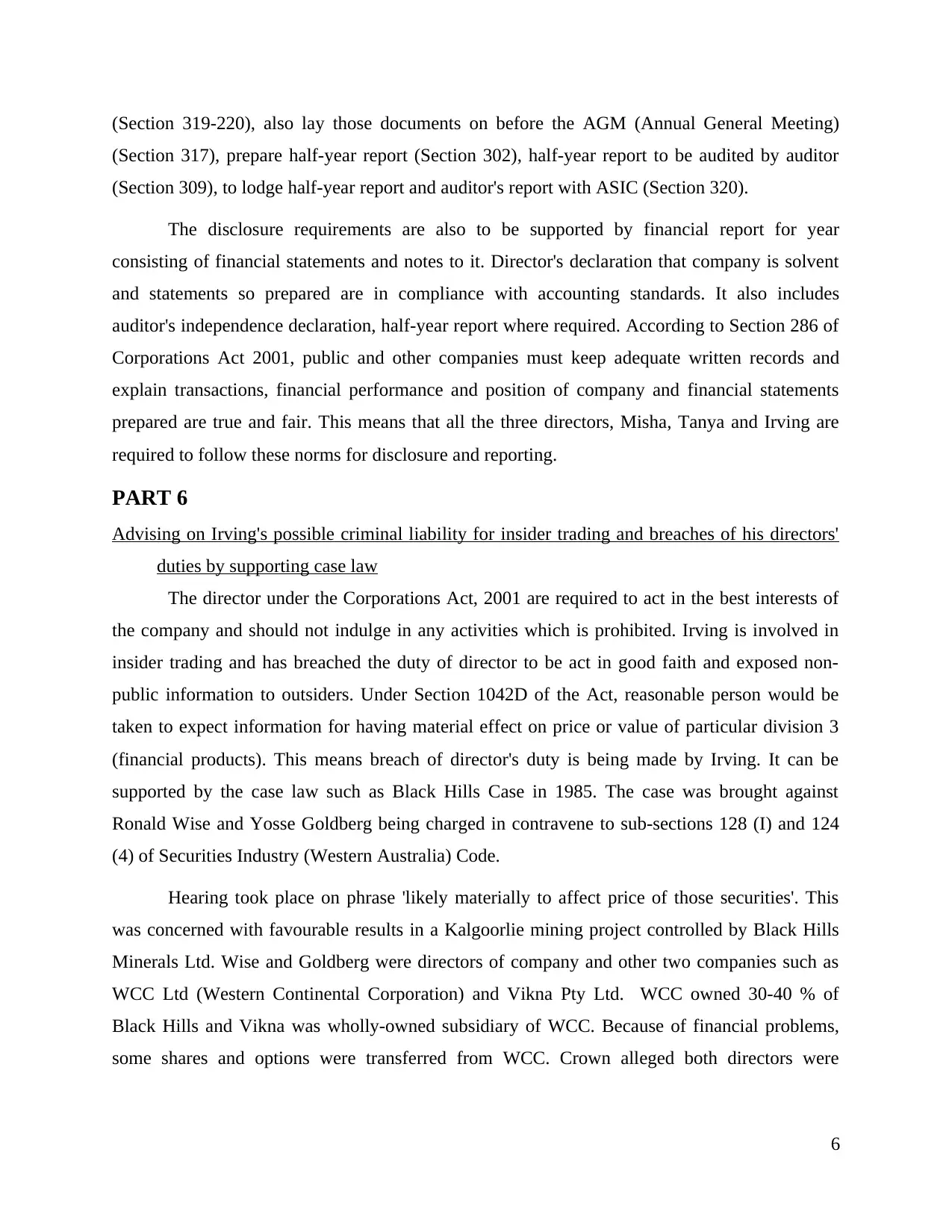
(Section 319-220), also lay those documents on before the AGM (Annual General Meeting)
(Section 317), prepare half-year report (Section 302), half-year report to be audited by auditor
(Section 309), to lodge half-year report and auditor's report with ASIC (Section 320).
The disclosure requirements are also to be supported by financial report for year
consisting of financial statements and notes to it. Director's declaration that company is solvent
and statements so prepared are in compliance with accounting standards. It also includes
auditor's independence declaration, half-year report where required. According to Section 286 of
Corporations Act 2001, public and other companies must keep adequate written records and
explain transactions, financial performance and position of company and financial statements
prepared are true and fair. This means that all the three directors, Misha, Tanya and Irving are
required to follow these norms for disclosure and reporting.
PART 6
Advising on Irving's possible criminal liability for insider trading and breaches of his directors'
duties by supporting case law
The director under the Corporations Act, 2001 are required to act in the best interests of
the company and should not indulge in any activities which is prohibited. Irving is involved in
insider trading and has breached the duty of director to be act in good faith and exposed non-
public information to outsiders. Under Section 1042D of the Act, reasonable person would be
taken to expect information for having material effect on price or value of particular division 3
(financial products). This means breach of director's duty is being made by Irving. It can be
supported by the case law such as Black Hills Case in 1985. The case was brought against
Ronald Wise and Yosse Goldberg being charged in contravene to sub-sections 128 (I) and 124
(4) of Securities Industry (Western Australia) Code.
Hearing took place on phrase 'likely materially to affect price of those securities'. This
was concerned with favourable results in a Kalgoorlie mining project controlled by Black Hills
Minerals Ltd. Wise and Goldberg were directors of company and other two companies such as
WCC Ltd (Western Continental Corporation) and Vikna Pty Ltd. WCC owned 30-40 % of
Black Hills and Vikna was wholly-owned subsidiary of WCC. Because of financial problems,
some shares and options were transferred from WCC. Crown alleged both directors were
6
(Section 317), prepare half-year report (Section 302), half-year report to be audited by auditor
(Section 309), to lodge half-year report and auditor's report with ASIC (Section 320).
The disclosure requirements are also to be supported by financial report for year
consisting of financial statements and notes to it. Director's declaration that company is solvent
and statements so prepared are in compliance with accounting standards. It also includes
auditor's independence declaration, half-year report where required. According to Section 286 of
Corporations Act 2001, public and other companies must keep adequate written records and
explain transactions, financial performance and position of company and financial statements
prepared are true and fair. This means that all the three directors, Misha, Tanya and Irving are
required to follow these norms for disclosure and reporting.
PART 6
Advising on Irving's possible criminal liability for insider trading and breaches of his directors'
duties by supporting case law
The director under the Corporations Act, 2001 are required to act in the best interests of
the company and should not indulge in any activities which is prohibited. Irving is involved in
insider trading and has breached the duty of director to be act in good faith and exposed non-
public information to outsiders. Under Section 1042D of the Act, reasonable person would be
taken to expect information for having material effect on price or value of particular division 3
(financial products). This means breach of director's duty is being made by Irving. It can be
supported by the case law such as Black Hills Case in 1985. The case was brought against
Ronald Wise and Yosse Goldberg being charged in contravene to sub-sections 128 (I) and 124
(4) of Securities Industry (Western Australia) Code.
Hearing took place on phrase 'likely materially to affect price of those securities'. This
was concerned with favourable results in a Kalgoorlie mining project controlled by Black Hills
Minerals Ltd. Wise and Goldberg were directors of company and other two companies such as
WCC Ltd (Western Continental Corporation) and Vikna Pty Ltd. WCC owned 30-40 % of
Black Hills and Vikna was wholly-owned subsidiary of WCC. Because of financial problems,
some shares and options were transferred from WCC. Crown alleged both directors were
6
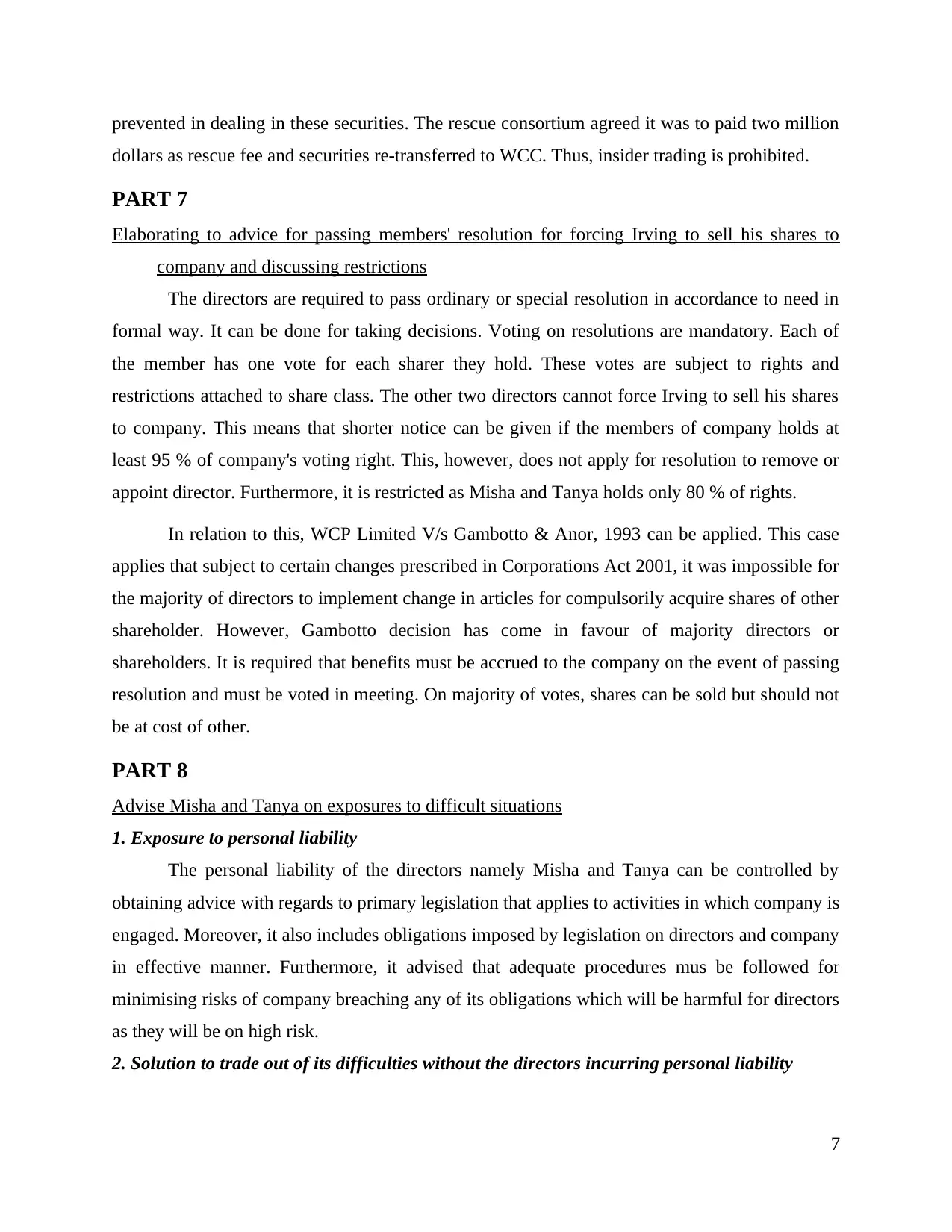
prevented in dealing in these securities. The rescue consortium agreed it was to paid two million
dollars as rescue fee and securities re-transferred to WCC. Thus, insider trading is prohibited.
PART 7
Elaborating to advice for passing members' resolution for forcing Irving to sell his shares to
company and discussing restrictions
The directors are required to pass ordinary or special resolution in accordance to need in
formal way. It can be done for taking decisions. Voting on resolutions are mandatory. Each of
the member has one vote for each sharer they hold. These votes are subject to rights and
restrictions attached to share class. The other two directors cannot force Irving to sell his shares
to company. This means that shorter notice can be given if the members of company holds at
least 95 % of company's voting right. This, however, does not apply for resolution to remove or
appoint director. Furthermore, it is restricted as Misha and Tanya holds only 80 % of rights.
In relation to this, WCP Limited V/s Gambotto & Anor, 1993 can be applied. This case
applies that subject to certain changes prescribed in Corporations Act 2001, it was impossible for
the majority of directors to implement change in articles for compulsorily acquire shares of other
shareholder. However, Gambotto decision has come in favour of majority directors or
shareholders. It is required that benefits must be accrued to the company on the event of passing
resolution and must be voted in meeting. On majority of votes, shares can be sold but should not
be at cost of other.
PART 8
Advise Misha and Tanya on exposures to difficult situations
1. Exposure to personal liability
The personal liability of the directors namely Misha and Tanya can be controlled by
obtaining advice with regards to primary legislation that applies to activities in which company is
engaged. Moreover, it also includes obligations imposed by legislation on directors and company
in effective manner. Furthermore, it advised that adequate procedures mus be followed for
minimising risks of company breaching any of its obligations which will be harmful for directors
as they will be on high risk.
2. Solution to trade out of its difficulties without the directors incurring personal liability
7
dollars as rescue fee and securities re-transferred to WCC. Thus, insider trading is prohibited.
PART 7
Elaborating to advice for passing members' resolution for forcing Irving to sell his shares to
company and discussing restrictions
The directors are required to pass ordinary or special resolution in accordance to need in
formal way. It can be done for taking decisions. Voting on resolutions are mandatory. Each of
the member has one vote for each sharer they hold. These votes are subject to rights and
restrictions attached to share class. The other two directors cannot force Irving to sell his shares
to company. This means that shorter notice can be given if the members of company holds at
least 95 % of company's voting right. This, however, does not apply for resolution to remove or
appoint director. Furthermore, it is restricted as Misha and Tanya holds only 80 % of rights.
In relation to this, WCP Limited V/s Gambotto & Anor, 1993 can be applied. This case
applies that subject to certain changes prescribed in Corporations Act 2001, it was impossible for
the majority of directors to implement change in articles for compulsorily acquire shares of other
shareholder. However, Gambotto decision has come in favour of majority directors or
shareholders. It is required that benefits must be accrued to the company on the event of passing
resolution and must be voted in meeting. On majority of votes, shares can be sold but should not
be at cost of other.
PART 8
Advise Misha and Tanya on exposures to difficult situations
1. Exposure to personal liability
The personal liability of the directors namely Misha and Tanya can be controlled by
obtaining advice with regards to primary legislation that applies to activities in which company is
engaged. Moreover, it also includes obligations imposed by legislation on directors and company
in effective manner. Furthermore, it advised that adequate procedures mus be followed for
minimising risks of company breaching any of its obligations which will be harmful for directors
as they will be on high risk.
2. Solution to trade out of its difficulties without the directors incurring personal liability
7
⊘ This is a preview!⊘
Do you want full access?
Subscribe today to unlock all pages.

Trusted by 1+ million students worldwide
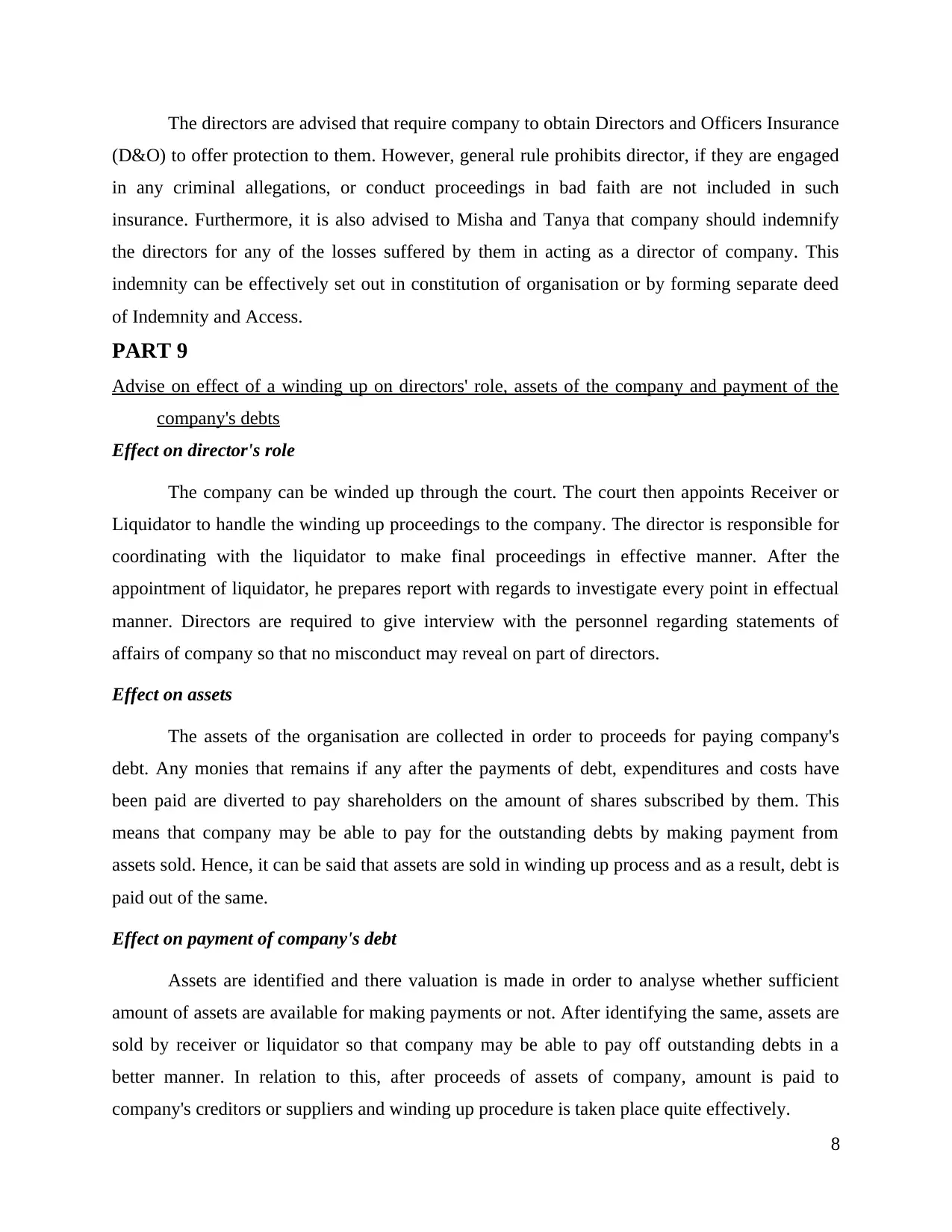
The directors are advised that require company to obtain Directors and Officers Insurance
(D&O) to offer protection to them. However, general rule prohibits director, if they are engaged
in any criminal allegations, or conduct proceedings in bad faith are not included in such
insurance. Furthermore, it is also advised to Misha and Tanya that company should indemnify
the directors for any of the losses suffered by them in acting as a director of company. This
indemnity can be effectively set out in constitution of organisation or by forming separate deed
of Indemnity and Access.
PART 9
Advise on effect of a winding up on directors' role, assets of the company and payment of the
company's debts
Effect on director's role
The company can be winded up through the court. The court then appoints Receiver or
Liquidator to handle the winding up proceedings to the company. The director is responsible for
coordinating with the liquidator to make final proceedings in effective manner. After the
appointment of liquidator, he prepares report with regards to investigate every point in effectual
manner. Directors are required to give interview with the personnel regarding statements of
affairs of company so that no misconduct may reveal on part of directors.
Effect on assets
The assets of the organisation are collected in order to proceeds for paying company's
debt. Any monies that remains if any after the payments of debt, expenditures and costs have
been paid are diverted to pay shareholders on the amount of shares subscribed by them. This
means that company may be able to pay for the outstanding debts by making payment from
assets sold. Hence, it can be said that assets are sold in winding up process and as a result, debt is
paid out of the same.
Effect on payment of company's debt
Assets are identified and there valuation is made in order to analyse whether sufficient
amount of assets are available for making payments or not. After identifying the same, assets are
sold by receiver or liquidator so that company may be able to pay off outstanding debts in a
better manner. In relation to this, after proceeds of assets of company, amount is paid to
company's creditors or suppliers and winding up procedure is taken place quite effectively.
8
(D&O) to offer protection to them. However, general rule prohibits director, if they are engaged
in any criminal allegations, or conduct proceedings in bad faith are not included in such
insurance. Furthermore, it is also advised to Misha and Tanya that company should indemnify
the directors for any of the losses suffered by them in acting as a director of company. This
indemnity can be effectively set out in constitution of organisation or by forming separate deed
of Indemnity and Access.
PART 9
Advise on effect of a winding up on directors' role, assets of the company and payment of the
company's debts
Effect on director's role
The company can be winded up through the court. The court then appoints Receiver or
Liquidator to handle the winding up proceedings to the company. The director is responsible for
coordinating with the liquidator to make final proceedings in effective manner. After the
appointment of liquidator, he prepares report with regards to investigate every point in effectual
manner. Directors are required to give interview with the personnel regarding statements of
affairs of company so that no misconduct may reveal on part of directors.
Effect on assets
The assets of the organisation are collected in order to proceeds for paying company's
debt. Any monies that remains if any after the payments of debt, expenditures and costs have
been paid are diverted to pay shareholders on the amount of shares subscribed by them. This
means that company may be able to pay for the outstanding debts by making payment from
assets sold. Hence, it can be said that assets are sold in winding up process and as a result, debt is
paid out of the same.
Effect on payment of company's debt
Assets are identified and there valuation is made in order to analyse whether sufficient
amount of assets are available for making payments or not. After identifying the same, assets are
sold by receiver or liquidator so that company may be able to pay off outstanding debts in a
better manner. In relation to this, after proceeds of assets of company, amount is paid to
company's creditors or suppliers and winding up procedure is taken place quite effectively.
8
Paraphrase This Document
Need a fresh take? Get an instant paraphrase of this document with our AI Paraphraser
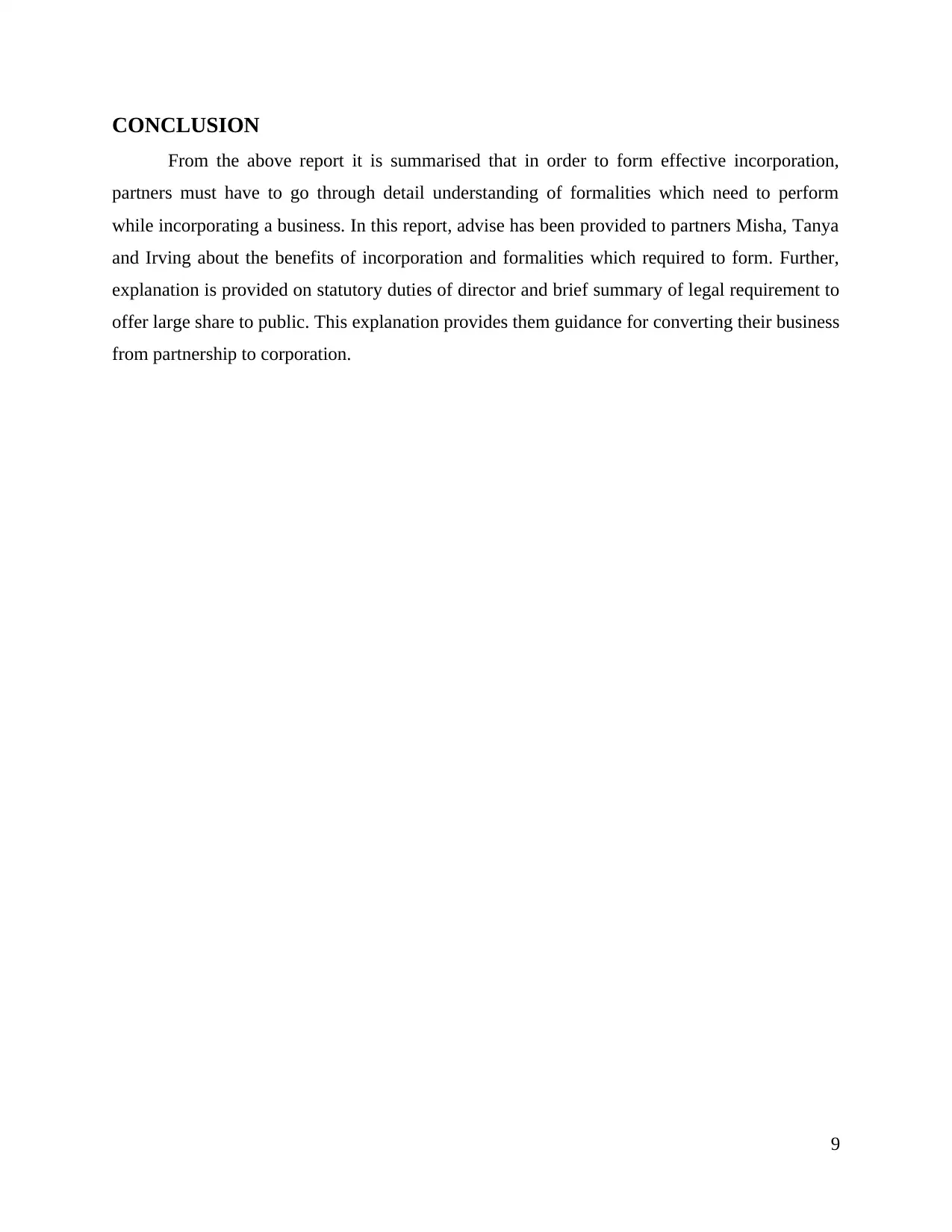
CONCLUSION
From the above report it is summarised that in order to form effective incorporation,
partners must have to go through detail understanding of formalities which need to perform
while incorporating a business. In this report, advise has been provided to partners Misha, Tanya
and Irving about the benefits of incorporation and formalities which required to form. Further,
explanation is provided on statutory duties of director and brief summary of legal requirement to
offer large share to public. This explanation provides them guidance for converting their business
from partnership to corporation.
9
From the above report it is summarised that in order to form effective incorporation,
partners must have to go through detail understanding of formalities which need to perform
while incorporating a business. In this report, advise has been provided to partners Misha, Tanya
and Irving about the benefits of incorporation and formalities which required to form. Further,
explanation is provided on statutory duties of director and brief summary of legal requirement to
offer large share to public. This explanation provides them guidance for converting their business
from partnership to corporation.
9
1 out of 11
Related Documents
Your All-in-One AI-Powered Toolkit for Academic Success.
+13062052269
info@desklib.com
Available 24*7 on WhatsApp / Email
![[object Object]](/_next/static/media/star-bottom.7253800d.svg)
Unlock your academic potential
Copyright © 2020–2025 A2Z Services. All Rights Reserved. Developed and managed by ZUCOL.




